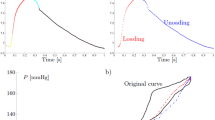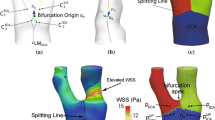Abstract
The goal of this study was to model the in vivo non-linear mechanical behavior of human common carotid arteries (CCAs) and then to compare wall stresses and associated contributions of micro-constituents in normotensive (NT) and treated hypertensive (HT) subjects. We used an established theoretical model of 3D arterial mechanics that assumes a hyperelastic, anisotropic, active–passive, and residually stressed wall. In vivo data were obtained non-invasively from CCAs in 16 NT (21–64 years old) and 25 treated HT (44–69 years old) subjects. The associated quasi-static boundary value problem was solved semi-analytically over a cardiac cycle while accounting for surrounding perivascular tissue. Best-fit values of model parameters, including those describing contributions by intramural elastin, fibrillar collagen, and vascular smooth muscle, were estimated by a non-linear least-squares method. The model (1) captured temporal changes in intraluminal pressure, (2) estimated wall stress fields that appeared to reflect the presence or absence of age and disease, and (3) suggested changes in mechanical characteristics of wall micro-constituents despite medical treatment of hypertension. For example, age was positively correlated with residual stresses and altered fibrillar collagen in NT subjects, which indirectly validated the modeling, and HT subjects had higher levels of stresses, increased smooth muscle tone, and a stiffer elastin-dominated matrix despite treatment. These results are consistent with prior reports on effects of age and hypertension, but provide increased insight into evolving contributions of cell and matrix mechanics to arterial behavior in vivo.
Similar content being viewed by others
References
Alastrué V, Pena E, Martinez MA, Doblaré M (2007) Assessing the use of the “opening angle method” to enforce residual stresses in patient-specific arteries. Ann Biomed Eng 35(10): 1821–1837
Baek S, Gleason RL, Rajagopal KR, Humphrey JD (2007) Theory of small on large: potential utility in computations of fluid-solid interactions in arteries. Comp Methods Appl Mech Eng 196(31–32): 3070–3078
Beaussier H, Masson I, Collin C, Bozec E, Laloux B, Calvet D, Zidi M, Boutouyrie P, Laurent S (2008) Carotid plaque, arterial stiffness gradient, and remodeling in hypertension. Hypertension 52(4): 729–736
Boutouyrie P, Bussy C, Lacolley P, Girerd X, Laloux B, Laurent S (1999) Association between local pulse pressure, mean blood pressure, and large-artery remodeling. Circulation 100(13): 1387–1393
Bussy C, Boutouyrie P, Lacolley P, Challande P, Laurent S (2000) Intrinsic stiffness of the carotid arterial wall material in essential hypertensives. Hypertension 35(5): 1049–1054
Cardamone L, Valentin A, Eberth JF, Humphrey JD (2009) Origin of axial prestretch and residual stress in arteries. Biomech Model Mechanobiol 8(6): 431–446
Cheng K-S, Baker CR, Hamilton G, Hoeks APG, Seifalian AM (2002) Arterial elastic properties and cardiovascular risk/event. Eur J Vasc Endovasc Surg 24(5): 383–397
Chuong CJ, Fung YC (1983) Three-dimensional stress distribution in arteries. J Biomech Eng 105(3): 268–274
Chuong CJ, Fung YC (1986) On residual stresses in arteries. J Biomech Eng 108(2): 189–192
Delfino A, Stergiopulos N, Moore JE Jr, Meister JJ (1997) Residual strain effects on the stress field in a thick wall finite element model of the human carotid bifurcation. J Biomech 30(8): 777–786
Eddhahak-Ouni A, Masson I, Allaire E, Zidi M (2009) Stochastic approach to estimate the arterial pressure. Eur J Mech A/Solid 28(4): 712–719
Ferruzzi J, Vorp DA, Humphrey JD (2010) On constitutive descriptors of the biaxial mechanical behaviour of human abdominal aorta and aneurysms. J R Soc Interface (in press). doi:10.1098/rsif.2010.0299
Fridez P, Rachev A, Meister JJ, Hayashi K, Stergiopulos N (2001) Model of geometrical and smooth muscle tone adaptation of carotid artery subject to step change in pressure. Am J Physiol Heart Circ Physiol 280(6): H2752–H2760
Fung YC (1993) Biomechanics: mechanical properties of living tissues. Springer, New York
Gasser TC, Holzapfel GA (2002) A rate-independent elastoplastic constitutive model for biological fiber-reinforced composites at finite strains: Continuum basis, algorithmic formulation and finite element implementation. Comput Mech 29(4–5): 340–360
Gasser TC, Ogden RW, Holzapfel GA (2006) Hyperelastic modelling of arterial layers with distributed collagen fibre orientations. J R Soc Interface 3(6): 15–35
Greenwald SE (2007) Ageing of the conduit arteries. J Pathol 211(2): 157–172
Hariton I, deBotton G, Gasser TC, Holzapfel GA (2007) Stress-modulated collagen fiber remodeling in a human carotid bifurcation. J Theor Biol 248(3): 460–470
Holzapfel GA, Gasser TC, Ogden RW (2000) A new constitutive framework for arterial wall mechanics and a comparative study of material models. J Elast 61(1–3): 1–48
Holzapfel GA, Sommer G, Auer M, Regitnig P, Ogden RW (2007) Layer-specific 3d residual deformations of human aortas with non-atherosclerotic intimal thickening. Ann Biomed Eng 35(4): 530–545
Holzapfel GA, Sommer G, Gasser CT, Regitnig P (2005) Determination of layer-specific mechanical properties of human coronary arteries with nonatherosclerotic intimal thickening and related constitutive modeling. Am J Physiol Heart Circ Physiol 289(5): H2048–H2058
Humphrey JD (2002) Cardiovascular solid mechanics: cells, tissues, and organs. Springer, New York
Humphrey JD, Eberth JF, Dye WW, Gleason RL (2009) Fundamental role of axial stress in compensatory adaptations by arteries. J Biomech 42(1): 1–8
Humphrey JD, Na S (2002) Elastodynamics and arterial wall stress. Ann Biomed Eng 30(4): 509–523
Kelly R, Hayward C, Avolio A, O’Rourke M (1989) Noninvasive determination of age-related changes in the human arterial pulse. Circulation 80(6): 1652–1659
Laurent S, Caviezel B, Beck L, Girerd X, Billaud E, Boutouyrie P, Hoeks A, Safar M (1994a) Carotid artery distensibility and distending pressure in hypertensive humans. Hypertension 23(6): 878–883
Laurent S, Girerd X, Mourad JJ, Lacolley P, Beck L, Boutouyrie P, Mignot JP, Safar M (1994b) Elastic-modulus of the radial artery wall material is not increased in patients with essential-hypertension. Arterioscler Thromb Vasc Biol 14(7): 1223–1231
Learoyd BM, Taylor MG (1966) Alterations with age in the viscoelastic properties of human arterial walls. Circ Res 18(3): 278–292
Mancia G, De Backer G, Dominiczak A, Cifkova R, Fagard R, Germano G, Grassi G, Heagerty AM, Kjeldsen SE, Laurent S, Narkiewicz K, Ruilope L, Rynkiewicz A, Schmieder RE, Boudier H, Zanchetti A (2007) 2007 guidelines for the management of arterial hypertension. J Hypertens 25(6): 1105–1187
Masson I, Boutouyrie P, Laurent S, Humphrey JD, Zidi M (2008) Characterization of arterial wall mechanical behavior and stresses from human clinical data. J Biomech 41(12): 2618–2627
Meinders JM, Brands PJ, Willigers JM, Kornet L, Hoeks AP (2001) Assessment of the spatial homogeneity of artery dimension parameters with high frame rate 2-d b-mode. Ultrasound Med Biol 27(6): 785–794
Paini A, Boutouyrie P, Calvet D, Zidi M, Agabiti-Rosei E, Laurent S (2007) Multiaxial mechanical characteristics of carotid plaque: analysis by multiarray echotracking system. Stroke 38(1): 117–123
Rachev A, Hayashi K (1999) Theoretical study of the effects of vascular smooth muscle contraction on strain and stress distributions in arteries. Ann Biomed Eng 27(4): 459–468
Saini A, Berry C, Greenwald S (1995) Effect of age and sex on residual stress in the aorta. J Vasc Res 32(6): 398–405
Schulze-Bauer CA, Holzapfel GA (2003) Determination of constitutive equations for human arteries from clinical data. J Biomech 36(2): 165–169
Sommer G, Regitnig P, Koltringer L, Holzapfel GA (2010) Biaxial mechanical properties of intact and layer-dissected human carotid arteries at physiological and supraphysiological loadings. Am J Physiol Heart Circ Physiol 298(3): H898–H912. doi:10.1152/ajpheart.00378.2009
Stalhand J (2009) Determination of human arterial wall parameters from clinical data. Biomech Model Mechanobiol 8(2): 141–148
Stalhand J, Klarbring A, Holzapfel GA (2008) Smooth muscle contraction: mechanochemical formulation for homogeneous finite strains. Prog Biophys Mol Biol 96(1–3): 465–481
Stalhand J, Klarbring A, Karlsson M (2004) Towards in vivo aorta material identification and stress estimation. Biomech Model Mechanobiol 2(3): 169–186
van Loon P (1977) Length-force and volume-pressure relationships in arteries. Biorheology 14(4): 181–201
Walmsley J, Campling M, Chertkow H (1983) Interrelationships among wall structure, smooth muscle orientation, and contraction in human major cerebral arteries. Stroke 14(5): 781–790
Wuyts FL, Vanhuyse VJ, Langewouters GJ, Decraemer WF, Raman ER, Buyle S (1995) Elastic properties of human aortas in relation to age and atherosclerosis: a structural model. Phys Med Biol 40(10): 1577–1597
Zulliger MA, Fridez P, Hayashi K, Stergiopulos N (2004) A strain energy function for arteries accounting for wall composition and structure. J Biomech 37(7): 989–1000
Zulliger MA, Stergiopulos N (2007) Structural strain energy function applied to the ageing of the human aorta. J Biomech 40(14): 3061–3069
Author information
Authors and Affiliations
Corresponding author
Rights and permissions
About this article
Cite this article
Masson, I., Beaussier, H., Boutouyrie, P. et al. Carotid artery mechanical properties and stresses quantified using in vivo data from normotensive and hypertensive humans. Biomech Model Mechanobiol 10, 867–882 (2011). https://doi.org/10.1007/s10237-010-0279-6
Received:
Accepted:
Published:
Issue Date:
DOI: https://doi.org/10.1007/s10237-010-0279-6




